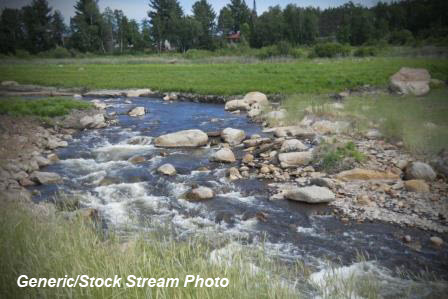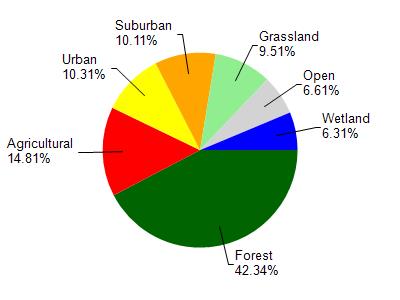
6.70 Miles
0 - 6.70
Cool-Cold Headwater, Coldwater
2018
Good
La Crosse
No
No
No
Fish and Aquatic Life
Overview
Pleasant Valley Creek, also known as Creek 18-2, is located in central La Crosse County. This stream flows in a westerly direction for approximately six miles before reaching the La Crosse River. It has a gradient of 30 feet per mile and flows through agricultural land with heavy pasturing, rural housing, and a golf course. Pleasant Valley Creek has been channelized as it runs parallel to I-90. After flowing through culverts under I-90 and railroad tracks, then through wetlands, the stream ultimately reaches the La Crosse River. Pleasant Valley Creek is not a classified trout stream.
A 1988 stream survey of Pleasant Valley Creek documented only forage fish species. Streambank erosion due to livestock was causing degradation of in-stream fish habitat. An updated fish and habitat survey should be conducted on Pleasant Valley Creek to determine its current condition.
Water chemistry testing of streams throughout La Crosse County was initiated by the La Crosse County Land Conservation Department in 1998. Baseflow conditions were targeted for testing as the most likely to show normal water quality conditions. Sampling takes place four times annually when no rainfall or snowmelt has occurred during the previous 72 hours. Between 1998 and 2001, Pleasant Valley Creek met the county phosphorus goal in only 7% and the county fecal coliform bacteria goal in approximately 50% of the samples taken. These data indicate a nutrient load that is likely also contributing to high bacterial counts. The county ranks Pleasant Valley Creek in the top 25% in priority compared to other streams for efforts to reduce phosphorus and bacterial contamination. La Crosse County should continue baseflow sampling of Pleasant Valley Creek to determine water quality trends.
Date 2002
Author Aquatic Biologist
Condition
Wisconsin has over 84,000 miles of streams, 15,000 lakes and milllions of acres of wetlands. Assessing the condition of this vast amount of water is challenging. The state's water monitoring program uses a media-based, cross-program approach to analyze water condition. An updated monitoring strategy (2015-2020) is now available. Compliance with Clean Water Act fishable, swimmable standards are located in the Executive Summary of Water Condition in 2018. See also the 'monitoring and projects' tab.
Reports
Recommendations
Monitor Aquatic Biology
Conduct biological (mIBI or fIBI) monitoring on Unnamed, WBIC: 1651000, AU:13991
Management Goals
Wisconsin's Water Quality Standards provide qualitative and quantitative goals for waters that are protective of Fishable, Swimmable conditions [Learn more]. Waters that do not meet water quality standards are considered impaired and restoration actions are planned and carried out until the water is once again fishable and swimmable
Management goals can include creation or implementation of a Total Maximum Daily Load analysis, a Nine Key Element Plan, or other restoration work, education and outreach and more. If specific recommendations exist for this water, they will be displayed below online.
Monitoring
Monitoring the condition of a river, stream, or lake includes gathering physical, chemical, biological, and habitat data. Comprehensive studies often gather all these parameters in great detail, while lighter assessment events will involve sampling physical, chemical and biological data such as macroinvertebrates. Aquatic macroinvertebrates and fish communities integrate watershed or catchment condition, providing great insight into overall ecosystem health. Chemical and habitat parameters tell researchers more about human induced problems including contaminated runoff, point source dischargers, or habitat issues that foster or limit the potential of aquatic communities to thrive in a given area. Wisconsin's Water Monitoring Strategy was recenty updated.
Grants and Management Projects
Monitoring Projects
| WBIC | Official Waterbody Name | Station ID | Station Name | Earliest Fieldwork Date | Latest Fieldwork Date | View Station | View Data |
|---|
| 1651000 | Unnamed | 10017145 | Creek 18-2 (Pleasant Valley) Station 1 - 180m Downstream Of Pleasant Valley Rd. | 10/24/2005 | 10/24/2005 | Map | Data |
| 1651000 | Unnamed | 10011664 | Pleasant Valley (Cr. 18-2) Station 2 Jim Shurson Property By Fire Pit 100 Yd Above Spring | | | Map | Data |
| 1651000 | Unnamed | 10014046 | Pleasant Valley Creek (Creek 18-2) Ne 1/4 Sw 1/4 S8 | | | Map | Data |
| 1651000 | Unnamed | 10011663 | Pleasant Valley (Cr. 18-2) Station 1bridge On Cth M | 7/9/2014 | 10/31/2018 | Map | Data |
|

Watershed Characteristics
Unnamed is located in the Lower La Crosse River watershed which is 145.46 mi². Land use in the watershed is primarily forest (42.30%), agricultural (14.80%) and a mix of urban (10.30%) and other uses (32.50%). This watershed has 295.20 stream miles, 1,187.12 lake acres and 5,641.64 wetland acres.
Nonpoint Source Characteristics
This watershed is ranked Medium for runoff impacts on streams, Not Ranked for runoff impacts on lakes and Low for runoff impacts on groundwater and therefore has an overall rank of Low. This value can be used in ranking the watershed or individual waterbodies for grant funding under state and county programs.However, all waters are affected by diffuse pollutant sources regardless of initial water quality. Applications for specific runoff projects under state or county grant programs may be pursued. For more information, go to surface water program grants.
Pleasant Valley Creek (18-2) is considered a Cool-Cold Headwater, Coldwater under the state's Natural Community Determinations.
Natural communities (stream and lake natural communities) represent model results and DNR staff valiation processes that confirm or update predicted conditions based on flow and temperature modeling from historic and current landscape features and related variables. Predicated flow and temperatures for waters are associated predicated fish assemblages (communities). Biologists evaluate the model results against current survey data to determine if the modeled results are corect and whether biological indicators show water quaity degradation. This analysis is a core component of the state's resource management framework. Wisconsin's Riverine Natural Communities.
Cool (Cold-Transition) Headwaters are small, usually perennial streams with cold to cool summer temperatures. Coldwater fishes are common to uncommon (<10 per 100 m), transitional fishes are abundant to common, and warm water fishes are uncommon to absent. Headwater species are abundant to common, mainstem species are common to absent, and river species are absent.